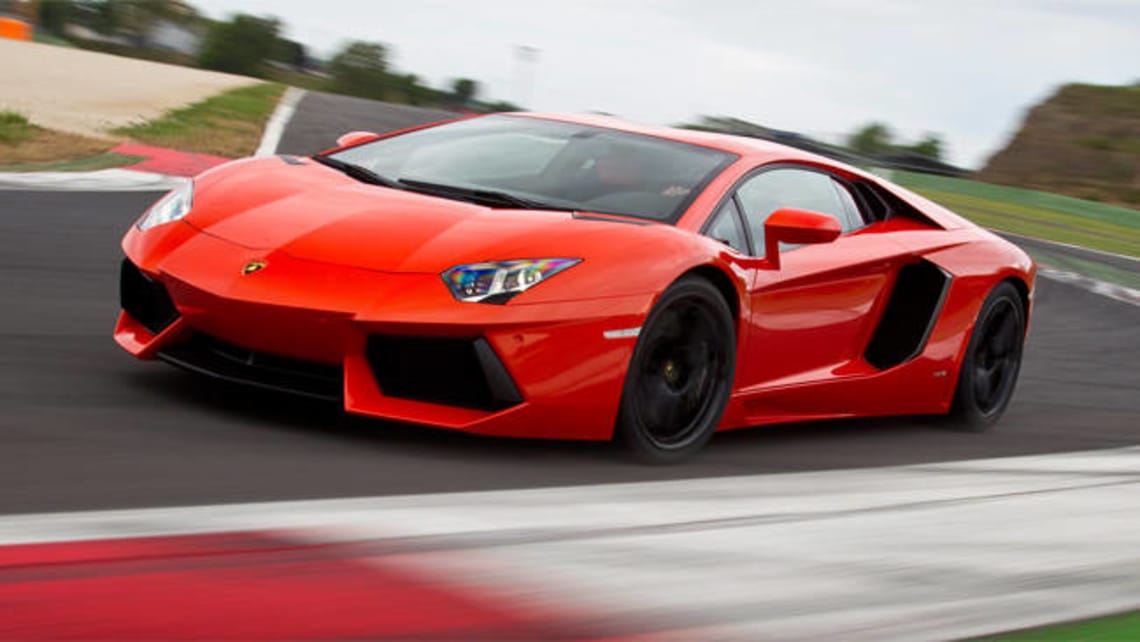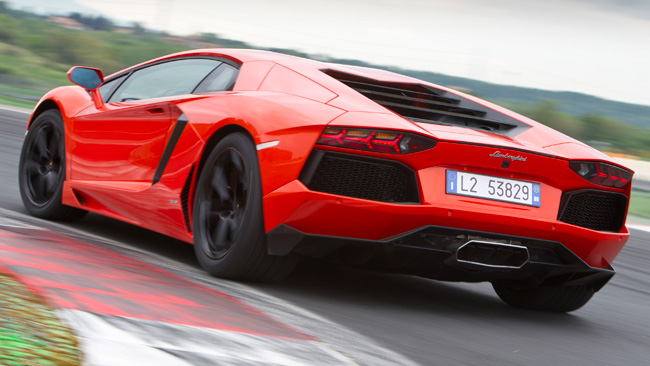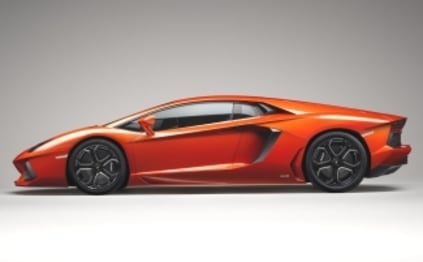
Lamborghini Aventador LP700-4 2011 Review
- Lamborghini Aventador
- Lamborghini Aventador 2011
- Lamborghini Aventador Reviews
- Lamborghini Reviews
- Lamborghini Coupe Range
- Coupe
- Lamborghini
- Prestige & Luxury Cars
- Motor shows

When it came time to replace its Murcielago supercar, Lamborghini knew it had its work cut out. As awesome as the big V12 monster was to drive, it could be a handful in the corners, its chromolly tube chassis was dated and its fuel consumption was gargantuan.
In Lamborghini president Stephan Winkelmann’s words, the Italian maker needed to leap ahead two full generations if it wanted to position itself at the forefront of the supercar world. Australians will see the results of Lamborghini’s efforts at this week’s Australian International Motor Show when the Aventador LP700-4 is revealed for the first time locally, but Carsguide has already driven the stunning high-performance machine in Europe.
The exotically-named Aventador highlights four key technologies, all aimed at delivering raw speed: a sophisticated new electronics system, a clever seven-speed sequential gearbox, a brand-new V12 engine, and an all-carbon chassis.
The result is a car that’s fast in a way that’s difficult to comprehend. It nails 0-100km/h in just 2.9 seconds, runs to a top speed of 350km/h and, thanks in part to Australia’s punitive luxury car tax, will cost the better part of a million dollars to drive away.
VALUE
Any time you get asked to hand over $754,600 for a car as opposed to a mansion, it’s difficult to work out whether it represents value or not, even bearing in mind that taxes account for in excess of $210K of that asking price.
But cars like the Aventador sell to a clientele that recognizes and values the exclusivity of such a machine, both in terms of the limited numbers sold, and in its status at the very top of the performance tree. And, to be perfectly honest, there’s nothing out there that’s quite like the Aventador.
Ferrari quit the mid-engined supercar business after the TestaRossa and now sells its V12s as front-engined grand tourers (even if the 599 GTO is an awesome machine). Nor does anything else have this level of carbon-fibre technology as its core. The rare as hens-teeth Pagani Zonda and upcoming McLaren MP4-12C both make extensive use of carbon technology, but both cars are a generation behind what Lamborghini is offering.
Despite the price, you don’t get limousine-like features inside the cabin, which is best described as comfortably functional. But where the Aventador excels is in developing enormous amounts of power and character, and delivering both brilliantly.
TECHNOLOGY
Firstly, the Aventador uses not one, but three different carbon-fibre technologies to create a chassis that is not only light, but so stiff that it passes the FIA’s current GT racing roof crush test without a roll cage.
The basis of this strength is an in-house technology called ‘RTM Lambo’ that needs a lot less heat and preparation time than other carbon-fibre manufacturing techniques. That’s backed up with tubular, braided carbon that is used to add strength in the windscreen pillars and along the sills, while more traditional carbon is used for the roof and windscreen pillar surfaces.
This magical material has resulted in a chassis that weighs just 175kg yet is so strong that it requires 33 tonnes of force on one corner to make it bend a single degree. It’s also been designed with ease of driving and building in mind, so both left- and right-hand drive buyers can sit straight, where the old car made them twist inwards a fraction.
But Lamborghini hasn’t stopped at the Aventador’s body. The car also features a race-bred pushrod suspension, with the dampers and springs sitting inboard instead of out by the wheels; an electrical system capable of processing half a billion calculations a second; and a lighter, faster all-wheel drive system.
There’s also a clever seven-speed automated-manual gearbox that reshuffles the traditional gear pairings so the computer can disengage one gear as it’s engaging the next one, all in just 0.05 seconds. That’s a touch slower than the fastest twin clutch gearboxes, but few will argue it’s tardy. It’s also brilliantly designed, weighing basically the same as the old ‘box, even with an extra gear.
Sadly, the new system heralds the demise of Lamborghini’s classic open-gate manual gearshift.
And then, of course, there’s the engine. At 6.5-litres it’s about the same size as the Murcielago’s V12, but the Aventador’s engine is all new and shares not a single screw with the old car. It produces 515kW at 8250rpm and 690Nm at 5500rpm, but the numbers just don’t do it justice…
DESIGN
If the Aventador’s look seems a little familiar, it’s probably because Lamborghini admits that’s a what it wanted. The company stretched the bounds of what it could manufacture in low volumes with its Reventon art car, and the Aventador is a little more conservative than that, but still clearly from the same design family. Inside, the story isn’t as convincing as the bodywork.
There’s a very high centre console, complete with a flip-up cover for the start button, but many of the standard materials don’t feel like they belong in a car costing this much. Customisation options means you can change them for much classier materials, but that’s an extra cost…
SAFETY
Testament to the inherent strength of carbon-fibre tubs such as that at the heart of the Aventador is seen from time to time when F1 drivers emerge unscathed from enormous crashes. Lamborghini insists the same strength is part of the Aventador’s DNA, pointing to the first rear crash test, which the car survived so well that engineers effectively replaced some panels and turned the same car around to do the side impact test as well.
We’ll probably have to take their word for it, too, because at these prices Australian safety authorities are unlikely to be slamming one into a wall any time soon. Regardless of its crash performance, the Aventador comes with the sort of active safety arsenal – enormous, sticky Pirelli tyres, 400mm carbon-ceramic front brakes and enough grip to hurt the necks of the unwise – that it’s hard to imagine how you’d crash one in the first place. Except through massive over-enthusiasm.

DRIVE
That V12 fires up instantly to give you a constant baseline of stomach-rumbling tension, even at idle. Yet, there are no histrionics from it and it will happily burst off the line from cold or just cruise in heavy traffic without tickling the temperature gauge.
The beautifully trimmed and snugly supportive sports seats are perfectly aligned in the straight ahead (trust me, it’s unusual in this style of car), though right-hand drive cars do suffer a bit of intrusion into the footwell from the front wheelarch. Blip the throttle and the revs explode skywards, so that anybody somehow oblivious to the stunning exterior shape is instantly aware of the beast’s presence.
With a fury of sound and revs and very little wheelspin thanks to its launch control system, the Aventador takes advantage of huge power and light weight (it’s only 1575kg) to explode off the line. You feel like you’ve been pinned to the seat by the hand of a giant. The steering, even in a straight line, comes alive with the action and, before you can comprehend it, the Aventador is demanding second gear.
Pull the little alloy paddle back behind the steering wheel and there’s a precise mechanical craaack, accompanied by a faint jolt before you continue, jet-like, towards the horizon.
Of course, going fast in a straight line isn’t a particularly difficult. Going around corners at speed is much more challenging, and Lamborghini has it overwhelmingly right. This car is alive in corners and shrinks around you the harder you drive it.
It has three driving modes that each change its character subtly. The basic Strada mode is quieter, with a slower shift speed and predictable understeer-at-the-limit handling; Sport gives you faster shifts, more exhaust noise and handling that tends to oversteer at the limit; while Corsa unleashes the Aventador to go at its absolute fastest.
Curiously, it also rides stupendously well and handles in a completely different way to the Murcielago. The old car used to frighten people into submission. The Aventador is no less of an event, but feels infinitely more trustworthy, constantly inviting the driver to push harder. Running through fast corners is like being in the ball on the end of the string. There’s nothing it doesn’t do brilliantly.
VERDICT
It’s a truly astonishing car, the Aventador LP700-4. It’s clearly the best supercar money can buy today and, with more tweaks to come (magnetic-ride suspension, lighter body panels and direct fuel injection to name just three), it should stay that way for a long time. Lamborghini could have rested on its laurels, safe in the knowledge that nobody else builds this sort of car anymore.
It didn’t. It’s a game changer for Lamborghini, pushing the company forward as an industry leader in electronics, in carbon-fibre and gearbox innovation while reinforcing its superfast, supersexy reputation. And it’s brilliant.
Lamborghini Aventador LP700-4
Price: $754,600 plus on roads
Warranty: 3 years unlimited
Resale: N/A
Service Interval: 15,000km
Engine: 6.5-litre, naturally aspirated V12, all alloy, 48-valves
Power: 515kW at 8250rpm, 690Nm at 5500rpm
Body: two-door coupe, carbon-fibre chassis
Weight: 1575kg
Transmission: seven-speed Independent Shifting Rods (ISR) sequential gearbox
Thirst: 17.2 L/100km + 398g/km CO2
Pricing guides
Range and Specs
| Vehicle | Specs | Price* | |
|---|---|---|---|
| (base) | 6.5L, PULP, 7 SP AUTO | $223,850 – 257,290 | 2011 Lamborghini Aventador 2011 (base) Pricing and Specs |
$223,850
Lowest price, based on third party pricing data







